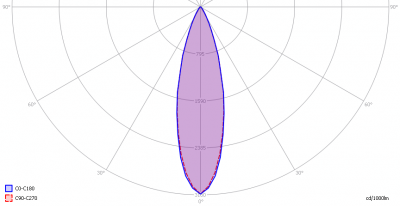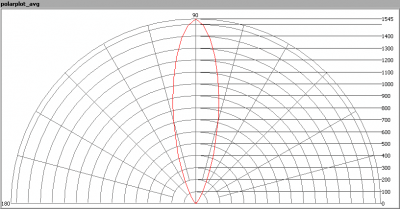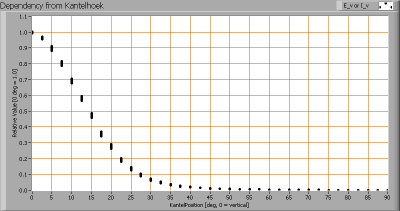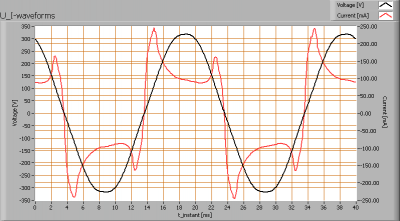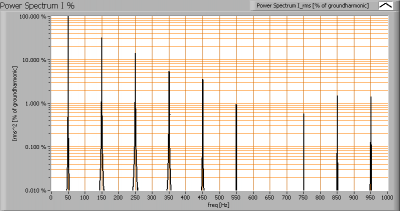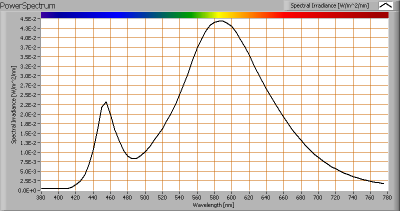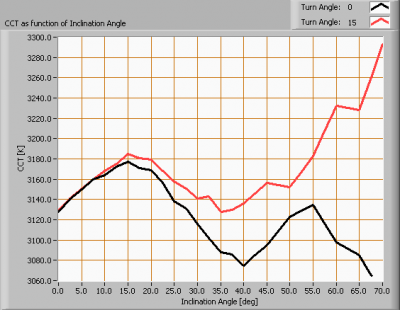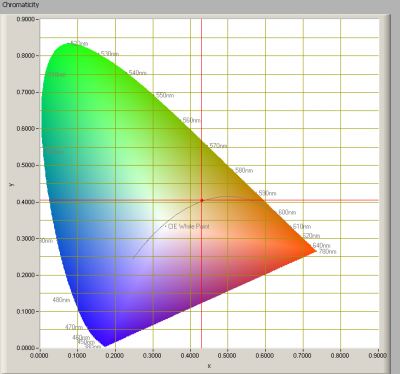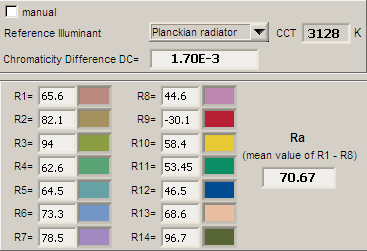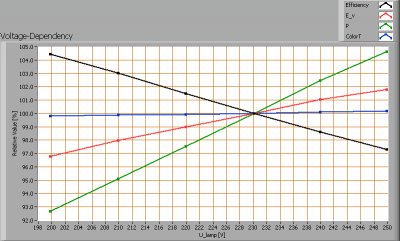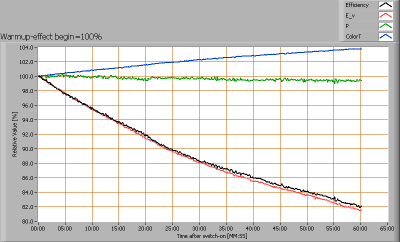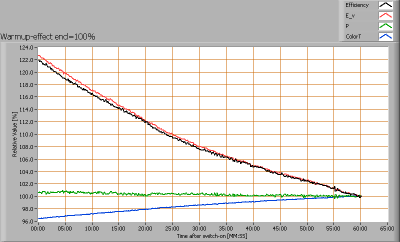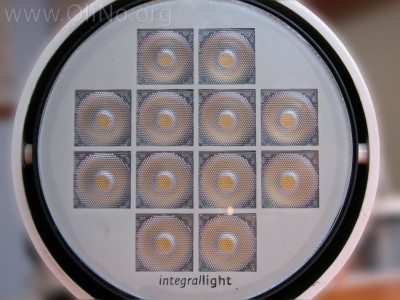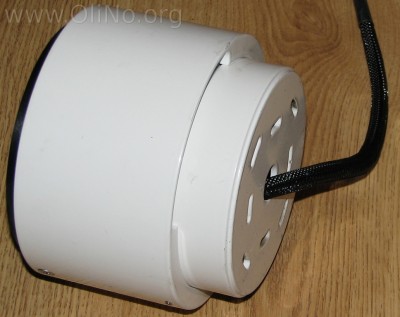Integrallight LED Surfaced Luminaire 1108.12
Posted by Marcel van der Steen in Led lights, Light measurements No Comments» presents an led based down lighter. It is their own design with 12 power leds. The led panel can be tilted. The used powerunit is dimmable. An Eulumdat file is added in this article.
presents an led based down lighter. It is their own design with 12 power leds. The led panel can be tilted. The used powerunit is dimmable. An Eulumdat file is added in this article.
See this overview for a comparison with other light bulbs.
Summary measurement data
| parameter | meas. result | remark |
|---|---|---|
| Color temperature | 3128 K | Warm white |
| Luminous intensity Iv | 1558 Cd | |
| Beam angle | 29 | |
| Power P | 23.4 W | |
| Power Factor | 0.69 | For every 1 kWh net power consumed, there has been 1.1 kVAhr for reactive power. |
| Luminous flux | 488 lm | |
| Luminous efficacy | 21 lm/W | |
| CRI_Ra | 78 | Color Rendering Index. |
| Coordinates chromaticity diagram | x=0.4301 and y=0.4059 | |
| Fitting | 230V | |
| D x H external dimensions | 134 x 110 mm | External dimensions of the luminaire. |
| L x W luminous area | 86 x 86 mm | Dimensions of the luminous area (used in Eulumdat file). This is equal to the size of the area in which the leds are. |
| General remarks | The ambient temperature during the whole set of measurements was 21.5-23 deg C. Warm up effect: during the warm up time the light intensity decreases with 18 % and the color temperature increases with 4 %. The lamp temperature was not stabilized after one hour. Voltage dependency: there is little dependency (variation 8 %) of illuminance and power consumption on the voltage. The Eulumdat file can be found via this link. |
|
| Measurement report (PDF) |
Eulumdat light diagram
An interesting graph is the light diagram, indicating the intensity in the C0-C180 and the C90-C270 plane. This light diagram below comes from the program Qlumedit, that extracts these diagrams from an Eulumdat file.
The light diagram giving the radiation pattern.
It indicates the luminous intensity around the light bulb. The C0-C180 plane and the C90-C270 give the same result as the light bulb is almost symmetrical along the z-axis.
The light gives a focused beam.
The unit is Cd/1000lm, meaning the intensity in Cd assuming there would be 1000 lumen in the measured light bulb. This enables comparing different types of light bulbs.
Illuminance Ev at 1 m distance, or luminous intensity Iv
Herewith the plot of the averaged luminous intensity Iv as a function of the inclination angle with the light bulb.
The radiation pattern of the light bulb.
This radiation pattern is not the same as the one given earlier. This is because of the (small) differences of beam angles in the different planes. In this graph the luminous intensity is given in Cd.
These averaged values are used (later) to compute the lumen output.
Intensity data of every measured turn angle at each inclination angle.
This plot shows per inclination angle the intensity measurement results for each turn angle at that inclination angle. There is little variation in intensity, for instance at 10 degrees inclination angle, the range in measured intensities was 67-71 % of the 0 degree inclination value.
As the average values of illumination per inclination angle will be used for further computations, there is no effect of any dispersion in intensity values on the further results.
When using the average values per inclination angle, the beam angle can be computed, being 29 degrees.
Luminous flux
With the averaged illuminance data at 1 m distance, taken from the graph showing the averaged radiation pattern, it is possible to compute the luminous flux.
The result of this computation for this light spot is a luminous flux of 488 lm.
Luminous efficacy
The luminous flux being 488 lm, and the power of the lightbulb being 23.4 W, yields a luminous efficacy of 21 lm/W.
A power factor of 0.69 means that for every 1 kWh net power consumed, a reactive component of 1.1 kVAr was needed.
| Light bulb voltage | 230 V |
| Light bulb current (luminaire) | 148 mA |
| Power P | 23.4 W |
| Apparent power S | 34.0 VA |
| Power factor | 0.69 |
Of this light bulb the voltage across ad the resulting current through it are measured and graphed.
Voltage across and current through the lightbulb
The current shows peaks at voltage polarity changes. This indicates the use of a switched mode power supply. The current has the same phase as the voltage, however it does not have a sine form (at all). Therefore the power factor is less than one.
Also the power spectrum of the current is determined.
The powerspectrum of the current through the light bulb.
There are higher harmonics apparent in the spectrum.
Color temperature and Spectral power distribution
The spectral power distribution of this light bulb.
The measured color temperature is about 3150 K which is warm white.
This color temperature is measured straight underneath the light bulb. Below a graph showing the color temperature for different inclination angles.
Color temperature as a function of inclination angle.
The colortemperature is given for inclination angles up to 65 degrees since at larger inclination angles there is too little illumination.
The value stays within +/- 4 % of its initial value at 0 degrees inclination angle.
Chromaticity diagram
The chromaticity space and the position of the lamp’s color coordinates in it.
The light coming from this lamp is close to the Planckian Locus (the black path in the graph).
Its coordinates are x=0.4301 and y=0.4059.
Color Rendering Index (CRI) or also Ra
Herewith the image showing the CRI as well as how well different colors are represented (rendered). The higher the number, the better the resemblance with the color when a black body radiator would have been used (the sun, or an incandescent lamp).
Each color has an index Rx, and the first 8 indexes (R1 .. R8) are averaged to compute the Ra which is equivalent to the CRI.
CRI of the light of this lightbulb.
The value of 71 is lower than 80 which is considered a minimum value for indoor usage.
Note: the chromaticity difference is 0.0017 indicates the distance to the Planckian Locus. Its value is lower than 0.0054, which means that the calculated CRI result is meaningful.
Voltage dependency
The dependency of a number of lamp parameters on the lamp voltage is determined. For this, the lamp voltage has been varied and its effect on the following lamp parameters measured: illuminance E_v [lx], color temperature CT or correlated color temperature CCT [K], the lamppower P [W] and the luminous efficacy [lm/W].
Lamp voltage dependencies of certain light bulb parameters, where the value at 230 V is taken as 100 %.
The consumed power and the illuminance vary little when the voltage varies between 200 – 250 V. This variation is linear and less than 8 %.
When the voltage at 230 V varies with + and – 5 V, then the illuminance varies with less than + and – 0.5 %, which will not be visible when the voltage changes abruptly.
Warm up effects
After switch on of a cold lamp, the effect of heating up of the lamp is measured on illuminance E_v [lx], color temperature CT or correlated color temperature CCT [K], the lamppower P [W] and the luminous efficacy [lm/W].
Effect of warming up on different light bulb parameters. At top the 100 % level is put at begin, and at bottom at the end.
Warm up time is longer than 1 hour. During that time the light output decreased with 18 % and the color temperature increased 4 %.
Photos
LEDs close up.
Side and back view, with the cable (dim cable and power cable in it)
